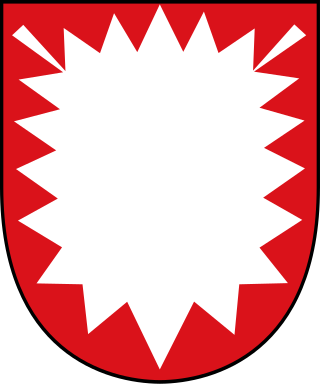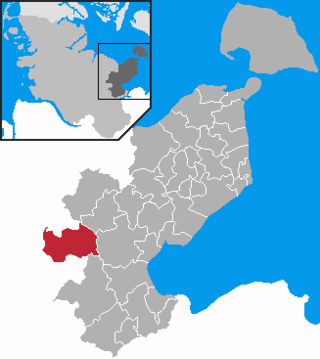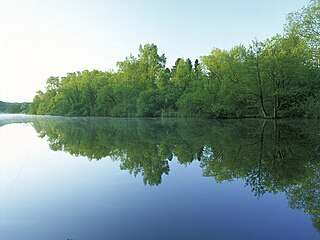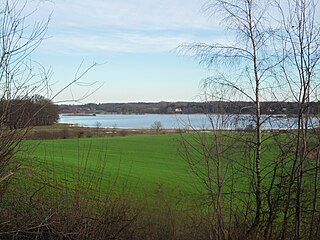Plön is a district in Schleswig-Holstein, Germany. It is bounded by the districts of Ostholstein and Segeberg, the city of Neumünster, the district of Rendsburg-Eckernförde, the city of Kiel and the Baltic Sea.
Ostholstein is a district in Schleswig-Holstein, Germany. It is bounded by the districts of Stormarn, Segeberg and Plön, the Baltic Sea and the city of Lübeck. Geographically, the district covers the vast majority of what is considered to be the peninsular of Wagria.

Holstein is the region between the rivers Elbe and Eider. It is the southern half of Schleswig-Holstein, the northernmost state of Germany.

Eutin is the district capital of Eastern Holstein county located in the northern German state of Schleswig-Holstein. As of December 2022, the town had some 17,000 inhabitants.

Bosau is a municipality on the Great Plön Lake the district of Ostholstein, in Schleswig-Holstein, Germany. It is situated approximately 13 km west of Eutin, and 30 km southeast of the state capital of Kiel.

The Großer Plöner See or Lake Plön is the largest lake (30 km²) in Schleswig-Holstein, Germany. It is located near the town of Plön. Its main tributary, as well as its main outflow, is the River Schwentine.

The Schwentine is a river in the North German state of Schleswig-Holstein. It is approximately 62 kilometres (39 mi) long and rises on the hill of Bungsberg, the highest point in the state, near the village of Kasseedorf in Ostholstein. It then runs from its source to Kiel where it flows into the Kiel Fjord, a bay of the Baltic Sea. It passes through several lakes, including the Großer Plöner See, the largest lake in Schleswig-Holstein, as well as the towns Eutin, Malente, Plön, Preetz and Kiel.

The Dieksee is a lake in the Holstein Switzerland region of North Germany.

The Kleine Plöner See is a lake in Holstein Switzerland in North Germany.

The Sibbersdorfer See is a lake in the district of Ostholstein within the region known as Holstein Switzerland in the North German state of Schleswig-Holstein.

The Schleswig-Holstein Uplands or Schleswig-Holstein Morainic Uplands is one of the three landscapes of the German state of Schleswig-Holstein; the others being the marsch and the geest. In addition, the gently rolling hills or Hügelland of the Baltic Uplands, the many small lakes and the long, deep embayments (Förde) formed by the moraines of the Weichselian Ice Age are characteristic features of the area. Its best-known towns are Kiel, Lübeck and Flensburg. The highest elevation in the area is the Bungsberg in the region known as Holstein Switzerland. On the Bungsberg is the only ski lift in the state.

Wagria is the northeastern part of Holstein in the German state of Schleswig-Holstein, corresponding roughly to the districts of Plön and Ostholstein. The word "Wagria" is derived from the Slavic Lechites tribe of Wagri, which meant "those who live by the bays".

Holsteinische Schweiz station is a railway station by the Kellersee lake on the Malente-Gremsmühlen–Lütjenburg railway in Schleswig-Holstein. It was opened on 25 May 1890. The entire route was built due to the efforts of businessman Johannes Janus, who ran the Hotel Holsteinische Schweiz after which the station was named.

Eutin Castle in Eutin in the north German district of Ostholstein is the cultural centre and nucleus of the town. Taken together, this castle, Gottorf Castle and Glücksburg Castle, form the most important group of courtly secular buildings in the state of Schleswig-Holstein.

The Holstein Switzerland Nature Park is a German federal nature park in the Holstein Switzerland region of Schleswig-Holstein.

Tourism is an important economic factor for Germany's northernmost state of Schleswig-Holstein.

The Kiel–Lübeck railway is a non-electrified, mostly single-track railway line in eastern Schleswig-Holstein in north Germany. It links Kiel and Lübeck, the only two large cities in the state. Passenger services on the 81-kilometre route are currently (2010) operated by DB Regio.

The Malente–Lütjenburg railway was a standard gauge, branch line in the north German state of Schleswig-Holstein. It was built by the businessman, Janus, who ran the Holsteinische Schweiz hotel, that gave its name to the local station on the line. It is currently closed.

The Neumünster–Ascheberg railway runs from the mid Holstein city of Neumünster east to Ascheberg (Holstein) near Plön in the German state of Schleswig-Holstein. The 26 kilometre line is currently closed, although there is a campaign to reopen it.






















